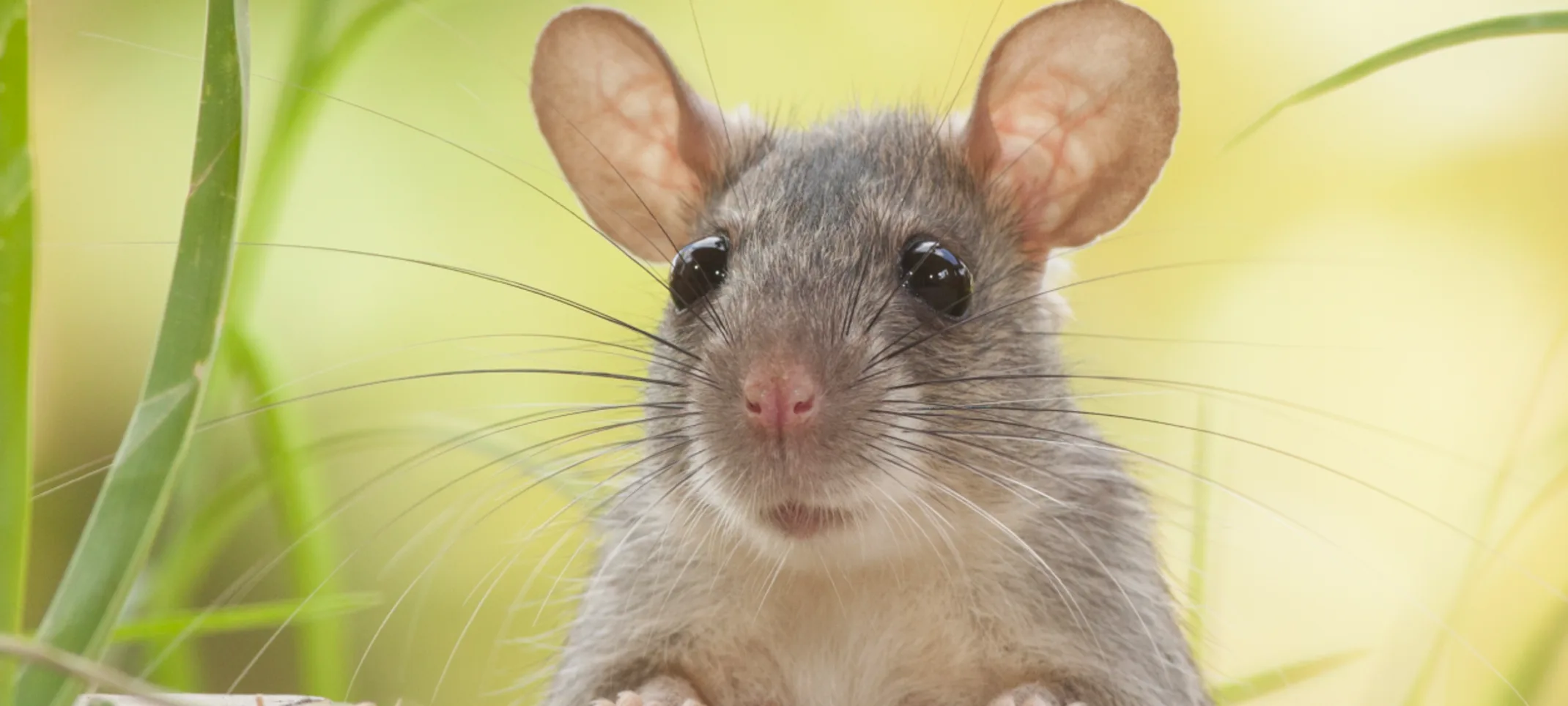I-20 Animal Medical Center
Rat Husbandry
Rats make excellent pets. They are friendly, clean, and easy to handle once they get used to an owner.

Rats make excellent pets. They are friendly, clean, and easy to handle once they get used to an owner. Rats are extremely intelligent, and through positive reward-based training, can learn vocal cues just like dogs can! Rats enjoy living in small groups, with same-sex groupings being best. Neutering males will help them live more peacefully with other males as well.
Rats tend to be more active in the evenings because they are nocturnal. Rats love to chew, and because they have teeth that continuously grow, chewing is both an enrichment activity and a necessity for them. Commercial wood chew toys, cardboard, and untreated hardwood branches (fruit tree branches are best) make great chew toys for rats. Rats range in size from 250-600 grams, and live on average 2-3 years.
Getting to Know Your New Rat
When you first get a new rat as a pet, gentle handling is necessary and you need to move at a pace that your rat finds comfortable. Too much handling too soon (before your rat gets to know you) can cause stress. Luckily, rats are typically curious and friendly creatures, and should get used to being handled fairly quickly. NEVER pick a rat up by the tail! This can hurt your rat.
The best way to pick up your rat is to gently scoop them up in your hands, or pick them up gently with your hand placed over their back. Save your rat’s treats for handling and training times – by giving your rat his favorite foods you are teaching him that it is always fun to be with you! This is called positive reinforcement training, and is the best way to teach your rat new things.
Housing
A safe, well ventilated cage is necessary for your rat’s health. Cages should be a minimum of 12” high and 24” long, but the bigger the better. If housing multiple rats together, larger commercial cages are ideal to avoid overcrowding. Cages with multiple levels allow rats to explore and exercise. Flooring should be solid to avoid trapped toes and foot-pad injuries. We do not recommend aquarium or terrarium glass enclosures because these will trap ammonia and other odors within the cage. If the cage sides are wire mesh, it is important to make sure the mesh is small enough that toes and legs cannot get stuck in the mesh squares.
Rats should have multiple places to hide in the cage; hide boxes and nest hammocks are great options for rats. Rats also enjoy a running wheel. Just make sure the wheel has a solid running surface, not open squares, because toes can get caught in the squares and cause injuries.
Substrate
We only recommend using recycled newspaper or paper products, such as Carefresh bedding, in your rat’s cage. Natural beddings (cedar, pine, aspen, and wood chips or shavings) have a tendency to grow microorganisms like bacteria and fungi, even when cleaned appropriately and often. They also can create dust that can cause allergies in both the rats and their people. Respiratory diseases are common in rats, and those that are housed on natural beddings are at an increased risk for problems.
Nutrition
Rats should be fed a commercially available pelleted diet. Ideal brands of food include Oxbow, Mazuri or Kaytee pellets. The pellets can be offered free choice (usually a ceramic dish is preferred because it is heavier and won’t spill over as easily, or a feeding hopper is also a great choice), unless your rat is getting overweight, which is a common problem in pet rats. Obesity can lead to arthritis, increased risk of mammary tumors, and breathing problems. Rats that are becoming overweight should have a diet plan made by a veterinarian and frequent weight re-checks.
Good treats for rats include fresh vegetables and fruits, and limited sweet treats like commercially available yogurt treats. Water should always be available to your rats and should be offered from a cage sipper bottle. Fresh water should be given each day. Make sure to thoroughly clean the water bottle and food dishes regularly to avoid bacterial buildup. Hot water and dish soap can be used to clean the dishes; just make sure and rinse them thoroughly.
Medical Care
New pet rats should be examined within the first week to look for any signs of illness and intestinal parasites. Bring your rat in a carrier or travel cage for safety. Exams should then be performed twice a year to make sure your rat is healthy. Preventative spaying and neutering is helpful to not only prevent certain diseases but also increase lifespan. Knowing the common diseases in rats and what signs to look for will help you know if you need to bring your rat in for an exam.
Exotic pets tend to hide signs of illness until they can no longer possibly maintain the appearance of being normal. This is because they are prey animals, and their instincts tell them that to survive they must look happy and healthy or they will be targeted by predators. Unfortunately for us, this means that usually when we first notice our pet rats are sick, they have actually been sick for days if not weeks. You usually don’t have the luxury of a “wait and see” approach to see if your rat is going to get better without treatment. Early medical care is vital to helping your rat!
Common Diseases In Rats:
Appearance of Bleeding From The Eyes Or Nose
This scares owners that see this syndrome for the first time, because it actually does look like your rat is bleeding from the eyes! This is actually called porphyrin staining. Porphyrin is a pigment that is secreted from a gland behind the eyes, and it occurs during periods of stress or illness. If you see this, it is a sign that something is wrong with your rat and he needs to see a doctor ASAP
Respiratory Disease
Most rats are exposed to a bacteria called Mycoplasma before you ever get them into your home. This bacteria causes some rats to get chronic respiratory issues like sneezing, which can then progress into a chronic pneumonia. Signs to watch for include sneezing, fast breathing, clicking noises when breathing, lethargy, and appetite loss. Antibiotics can manage this disease, but it can never be cured and lifelong management is usually necessary.
Mammary Tumors
Both female and male rats can form mammary tumors. These are benign growths under the skin that feel squishy. These tumors start out small but can get very large, very quickly. Though they are typically benign, they can grow so big that they ulcerate and cause pain. Removing these tumors with surgery early on minimizes the risk of bleeding as well as prevents them from getting so big that surgery is no longer an option. When removing the mammary tumors in females, it is also best to go ahead and spay them at the same time so that we can hopefully reduce the number of mammary tumors that develop in the future. Keeping your rat from becoming overweight will also decrease the risk of mammary tumors.
Head tilt
We sometimes see rats come in for tilting their head to one side. They can also be off balance. Causes of a head tilt can include an inner ear infection, a brain infection (usually a result of long-term Mycoplasma infection), or a brain tumor.
A minimum of a 30 day quarantine period is recommended for any new pet being brought into a home with existing exotic pets. This is to protect the owner’s previous pets from any new diseases or parasites a new pet could be carrying. Most infectious diseases will have symptoms show up within that 30 day period. Quarantined pets should be kept in a separate room if possible, and have separate food and water bowls throughout the quarantine period. Handle your previous pets first, then handle your new pet last. After the quarantine period is over, and your new pet has shown no signs of illness and has seen a veterinarian, your previous pets should be safe from most communicable diseases.
